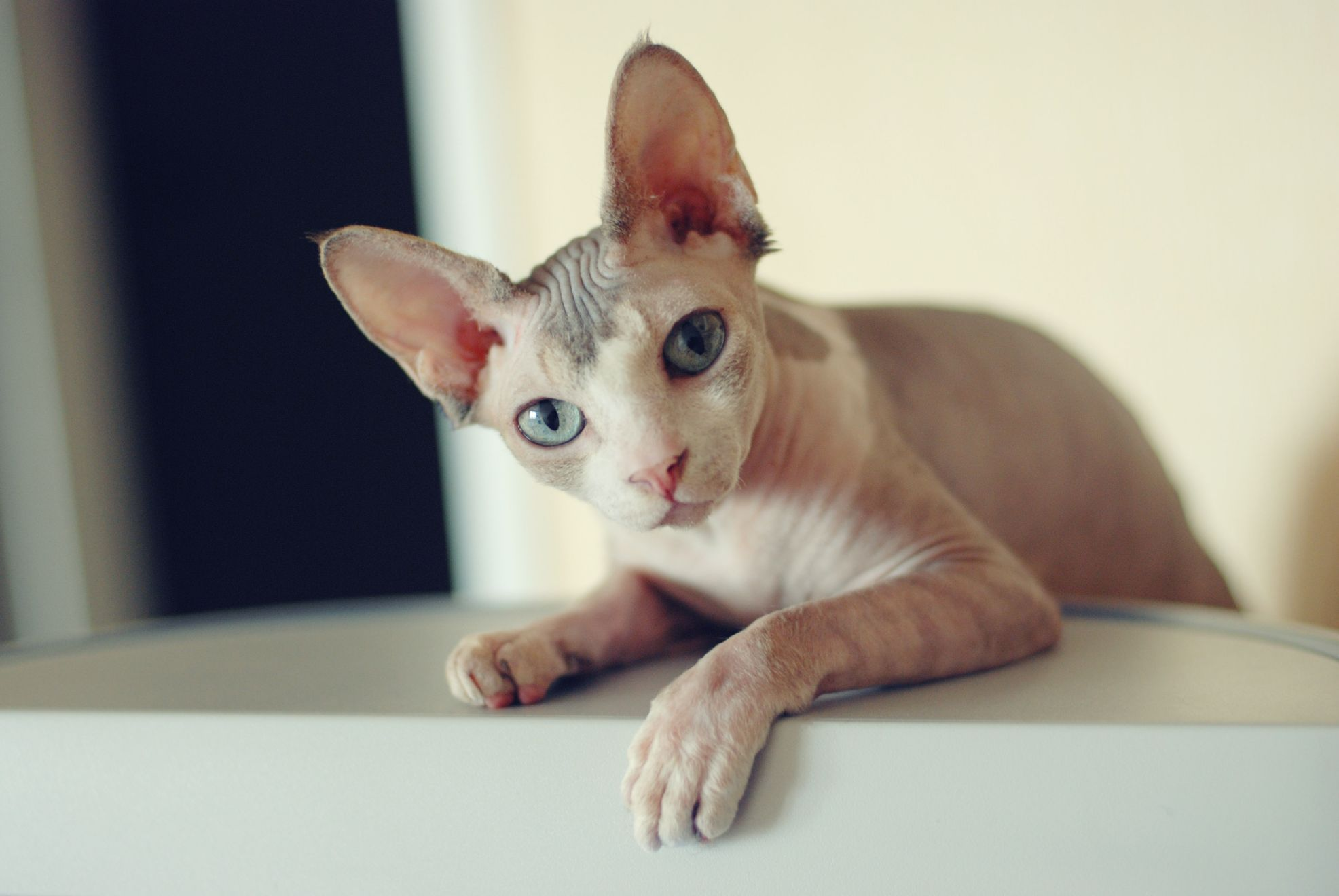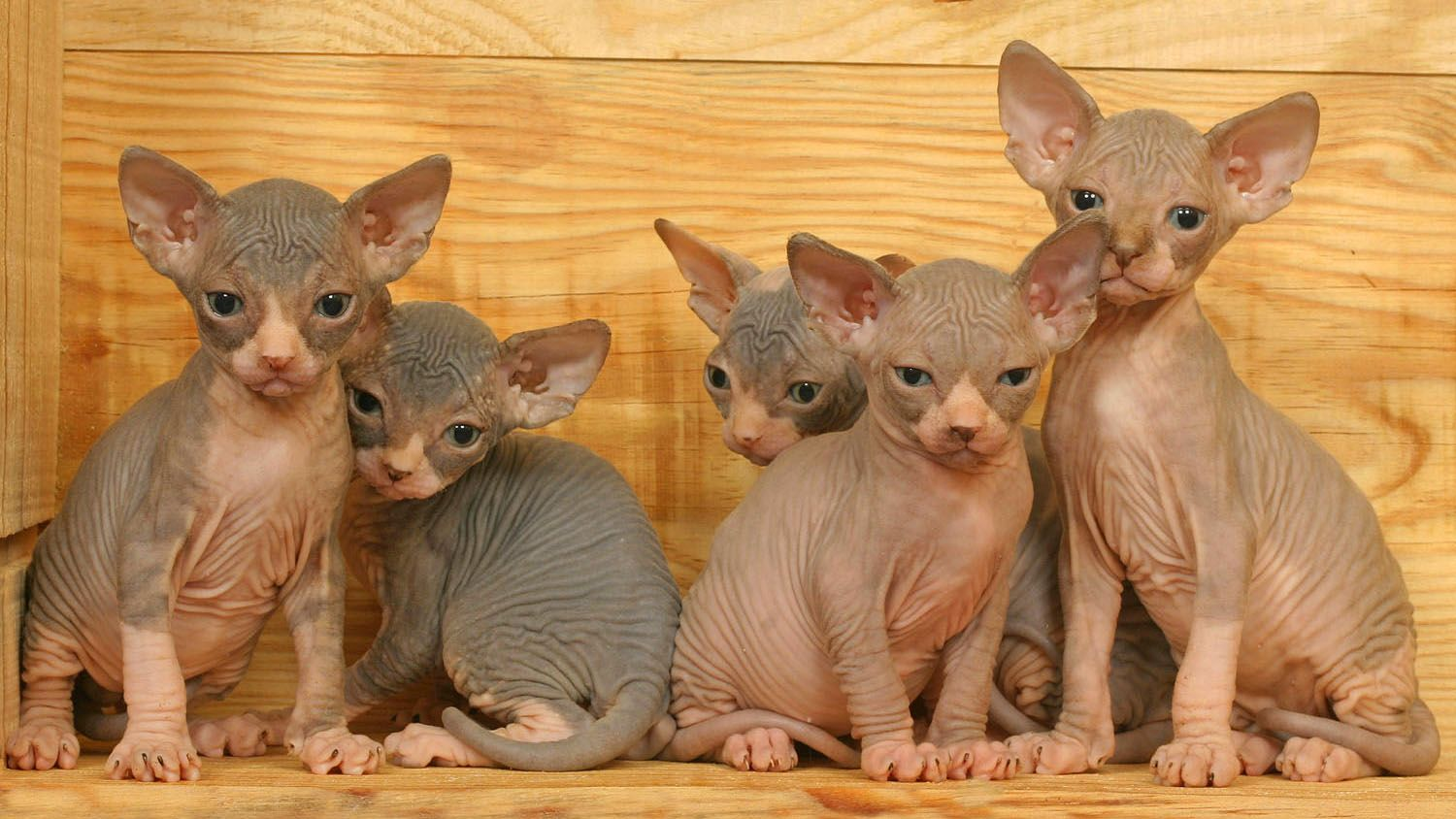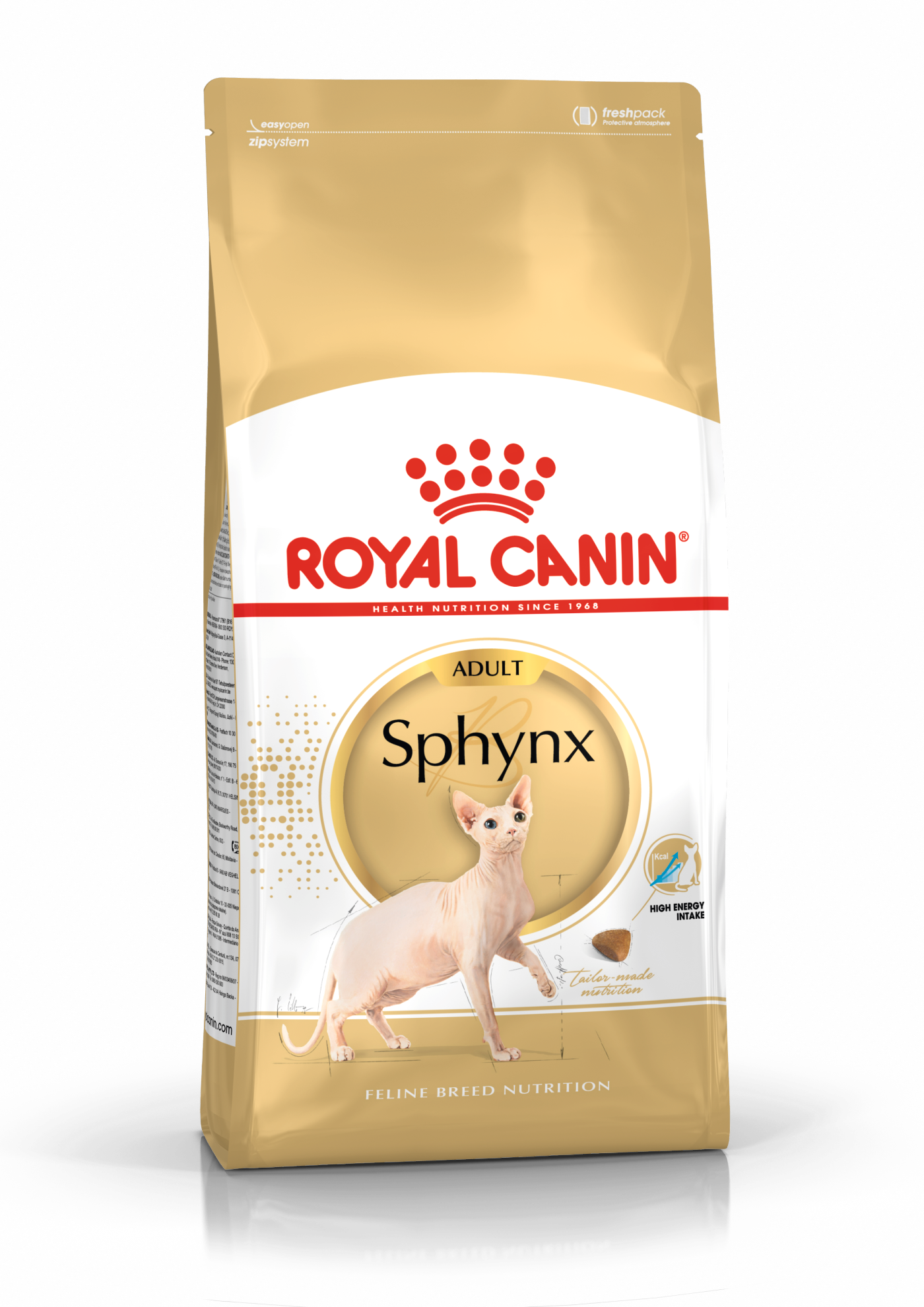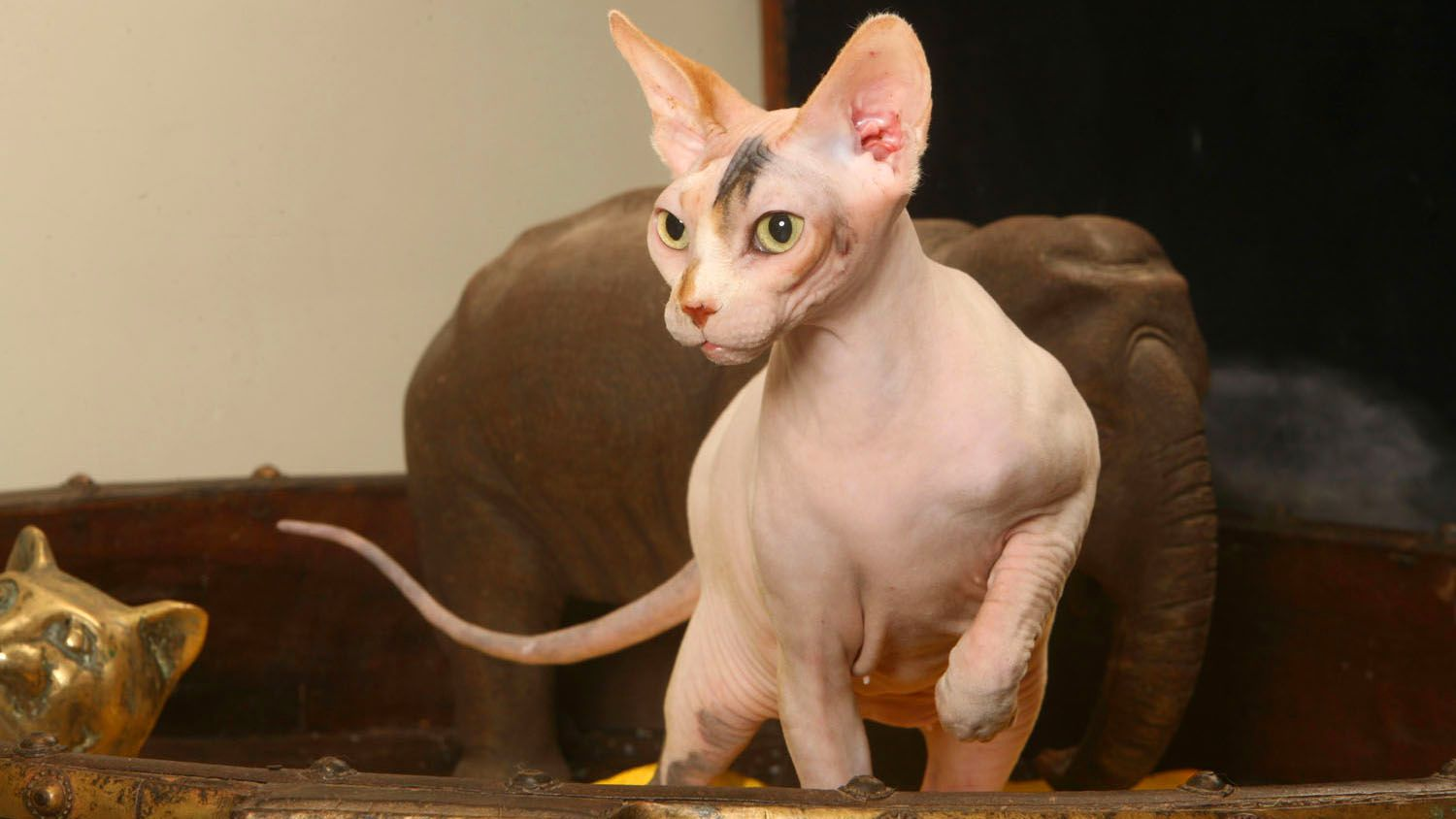Tölum um sphynx
Opinbert heiti: Sphynx
Önnur heiti: Kanadískur sphynx, kanadískur hárlaus köttur
Uppruni: Ontario, Kanada
Snyrtiþarfir
3 out of 5Orkuþörf *
4 out of 5Raddstyrkur
3 out of 5Environment (indoor or outdoor)
2 out of 5Hentar sem fjölskylduhundur?*
5 out of 5Samhæfni með öðrum gæludýrum
5 out of 5Getur verið einn?*
4 out of 5
| Male | Female |
|---|---|
| Height | Height |
| 0 - 0 cm | 0 - 0 cm |
| Weight | Weight |
| 4 - 7 kg | 3 - 4 kg |
| Kettlingur í vexti | Fullorðnir |
|---|---|
| 4 til 12 mánaða | 1 til 7 ára |
| Rosknir | Öldungar |
| 7 til 12 ára | Frá 12 ára |
Snyrtiþarfir
3 out of 5Orkuþörf *
4 out of 5Raddstyrkur
3 out of 5Environment (indoor or outdoor)
2 out of 5Hentar sem fjölskylduhundur?*
5 out of 5Samhæfni með öðrum gæludýrum
5 out of 5Getur verið einn?*
4 out of 5
| Male | Female |
|---|---|
| Height | Height |
| 0 - 0 cm | 0 - 0 cm |
| Weight | Weight |
| 4 - 7 kg | 3 - 4 kg |
| Kettlingur í vexti | Fullorðnir |
|---|---|
| 4 til 12 mánaða | 1 til 7 ára |
| Rosknir | Öldungar |
| 7 til 12 ára | Frá 12 ára |

Kynnstu sphynx
Allt sem þú þarft að vita um þessa tegund
Það voru ekki allir kettir skapaðir eins. Sphynx er einstakur köttur. Hann hefur engan feld sem orð er á hafandi, ólíkt öðrum köttum sem hafa feld sem einkennir þá. Sphynx hefur frábært lunderni og tjáir hrifningu sína og aðdáun af einlægni. Augun eru sítrónulaga og eyrun sem eru óvenju stór, sitja hátt á höfðinu. Það er bara eitt orð yfir þennan kött: Hann er svalur.
Þótt útlitið bendi til þess að tegundin sé frá tímum hins forna heims, á hún rætur að rekja til Kanada þar sem veðráttan er köld. Fyrsti sphynx-kettlingurinn kom í heiminn árið 1966 undan læðu sem var venjulegur heimilisköttur. Sphynx-kettlingurinn var stökkbreyttur. Tegundin hefur líka verið nefnd „kanadískur hárlaus köttur.“
Sphynx hefur einstakt lunderni. Hann er alltaf til í að kúra í fanginu á eiganda sínum. Hann er límdur við fólkið sitt og er bæði fjörugur og blíður. Sphynx veitt fátt betra en að vera í fanginu og hann þarf mikla athygli. Ef honum finnst hann ekki fá næga athygli, lætur hann vita af því á mjög greinargóðan hátt. Sphynx mjálmar ekki mikið en hann tjáir sig samt þannig að ekki fer milli mála hvað hann vill og það er einkum vegna þess að hann upplifir sig sem einn af fjölskyldunni.
Þá er það feldurinn. Eða dúnninn ... Sphynx er þakin mjúkum, fíngerðum hárum sem líkjast dúni og eru ólík öllu öðru sem sést í dýraríkinu. Minnir á vaskaskinn Stundum eru sphynx-kettir algjörlega hárlausir. Það er nauðsynlegt að bera lyktarlausa olíu á húðina til að verja hana en gættu þess að nota eingöngu olíu sem dýralæknar mæla með. Það þarf að baða sphynx-köttinn vikulega með barnasjampói eða öðru rakagefandi sjampói því annars getur húðfitan sest í húsgögn og aðra húsmuni. Sphynx er með náttúrulegar húðfellingar um nær allan líkamann.
Húðliturinn getur verið ýmis konar, til dæmis blár, flekkóttur og hvítur eða rauður og hvítur.
Líta þeir ekki út fyrir að vera klárir? Jú og þeir eru það. Svipurinn á sphynx ber með sér ákveðna visku, nánast eins og hann sé yfir aðra hafinn, eins og þarna sé köttur sem veit svörin við öllum lífsins gátum. Við fáum víst aldrei að vita það með vissu. Og það er allt í lagi.

2 staðreyndir um sphynx
1. Ekki ofnæmisfrí tegund
Þótt sphynx sé svo gott sem hárlaus, er hann ekki ofnæmisfrír. Feldleysið kemur sem sagt ekki í veg fyrir að fólk fái ofnæmisviðbrögð.
2. Lifandi hitapoki
Flestir gætu haldið að hárlaus köttur væri kaldur viðkomu. Það á ekki við um sphynx. Hann er einmitt heitur viðkomu. The breed hefur hærri líkamshita en aðrir kettir og efnaskiptin eru líka hraðari. Það þarf samt að gæta þess að honum verði ekki kalt.
Saga kynsins
Austurlönd fjær eða önnur framandi lönd er það fyrsta sem flestum dettur í hug þegar spurt er um uppruna sphynx-katta. Því fer fjarri. Sphynx er upprunninn í Toronto í Kanada. Ekki að Kanada sé ekki framandi land. Fyrsti sphynx-kettlingurinn sem vitað er um, kom í heiminn árið 1966 undan læðu sem hét Elizabeth og var venjulegur, yfirlætislaus svartur og hvítur heimilisköttur. Stökkbreyting hafði átt sér stað.
Kettlingurinn hlaut nafnið Prune eða Sveskja og var hún pöruð við aðra hárlausa ketti. Þar með hófst ræktun sphynx-katta. Sphynx var paraður við enska Devon Rex-ketti sem höfðu álíka stór eyru og mjög snöggan feld. Hárlausa afbrigðið var kynsterkara og því komu fleiri hárlausir kettlingar í heiminn úr þessari kynblöndun.
Sphynx hefur líka verið kallaður „kanadískur hárlaus köttur“ en fékk núverandi nafn þar sem hann þótti líkjast fornu egypsku köttunum í útliti.
Frá höfði til skotts
Líkamleg sérkenni sphynx
1.Ears
2.Head
3.Body
4.Tail
5.Coat

Hlutir sem gæta skal að
Sérkenni tegundarinnar og almennar heilsufarsupplýsingar. Hér eru áhugaverðar staðreyndir um sphynx-köttinn þinn
Sphynx-kettir geta fengið hjartasjúkdóma
Ef vandað er til ræktunarinnar, geta sphynx-kettir lifað lengi og verið heilsuhraustir alla ævi. Hjartasjúkdómur sem kallaður er ofvaxtarhjartavöðvakvilli (hypertrophic cardiomyopathy) er þekktur í tegundinni. Þessi sjúkdómur liggur yfirleitt í ættum og lýsir sér með þykknun á slegli. Þetta hljómar sem alvarlegur sjúkdómur en hægt er að meðhöndla hann með lyfjum. Farðu reglulega með köttinn þinn í dýralæknaskoðun til að ganga úr skugga um heilbrigði hans.
Er hann algjörlega hárlaus?
Það er áhugavert varðandi hárleysi Sphynx-katta að hárleysið getur verið misjafnlega mikið. Sumir kettir eru eins og flauel viðkomu meðan aðrir eru með húð sem er smjörkennd. Sumir sphynx-kettir eru með hárbrúska á nefi, eyrum, loppum eða skotti. Dúnmjúk og silkikennd hár þekja allan líkamann svo hann er alls ekki hárlaus með öllu.
Af hverju er hann svona kviðmikill?
Sphynx er sterkbyggður köttur þótt hann líti út fyrir að hafa viðkvæma líkamsbyggingu. Hugsanlega líta þeir út fyrir að vera mjög sverir um sig miðja vegna feldleysis en þeir eru einfaldlega sterklega byggðir, líka um miðjuna. Stundum er talað um sphynx-ketti sem „bollur“ af því þeir líta gjarnan út fyrir að vera nýbúnir að belgja sig út af fóðri. Hvað á að gefa sphynx-köttum að éta? Hárleysið veldur því að þeir þurfa að éta meira en loðnir kettir með feld sem heldur á þeim hita. Þess vegna leyfa ræktendur sphynx-köttunum að éta að vild.
Your vet may also discuss your Labrador’s weight management as a preventive measure. These simple tools can help you stay on top of potential problems.
Heilsusamlegt fóður, heilbrigðari köttur

Sérsniðið, heilsusamlegt fóður skiptir höfuðmáli til að viðhalda heilsu og fegurð sphynx. Fóður veitir líkamanum orku til að halda líkamsstarfseminni gangandi og heilfóður fyrir ketti ætti að innihalda rétt hlutföll næringarefna. Feeding them in this way will offer a diet that’s neither deficient nor excessive, both of which could have adverse effects on your cat’s health.
Hreint, ferskt vatn ætti alltaf að vera aðgengilegt til að tryggja góða starfsemi þvagfærakerfisins. Köttum er eðlislægt að éta litlar máltíðir, sjö til tíu sinnum á dag. Ef köttur fær ráðlagðan dagsskammt af fóðri einu sinni á dag, getur hann sjálfur ákveðið hversu mikið og oft hann étur
Eftirfarandi ráðleggingar eiga við um heilbrigð dýr. If your cat has health problems, please consult your veterinarian who will prescribe an exclusively veterinary diet.
Growth is an essential stage in a kitten’s life. It is a time of big changes, discoveries, and new encounters. Sphynx-kettlingar þurfa miklu meira af orku, prótínum, steinefnum og vítamínum en fullorðnir kettir. Þeir þurfa orku og næringarefni til viðhalds, vaxtar og uppbyggingar. A kitten’s growth comes in two phases:
Construction - From Birth to 4 Months:
Weaning is the transition a kitten makes from liquid - or maternal milk - to solid food. This period naturally corresponds to the time when they cut their milk teeth, at 3 to 6 weeks old. At this stage, kittens are not yet able to crunch, so a soft meal (rehydrated kibble or an adapted wet food) helps facilitate the transition between liquids and solids. Milli 4 og 12 vikna eftir fæðingu minnkar náttúrulegt ónæmi sem kettlingur fær frá broddmjólk móðurinnar – eða fyrstu mjólkinni – á meðan ónæmiskerfi kettlingsins þroskast smátt og smátt. Þessi mikilvægi tími, sem kallast ónæmisbil, krefst flókinnar blöndu andoxunarefna, þar á meðal E-vítamíns, til að styðja við náttúrulegar varnir líkamans. Kettlingar fara í gegnum ákaft og sérlega viðkvæmt vaxtarskeið þar sem þeir eiga til að vera með meltingarvandamál. Meðan á því stendur ætti fóðrið að vera bæði orkuríkt til að fullnægja nauðsynlegri vaxtarþörf þeirra og innihalda mjög auðmeltanleg prótín fyrir meltingarkerfið sem er enn að þroskast. góðgerlafæða (e. prebiotics), til dæmis ávaxtasykrur, geta bætt meltinguna með því að koma jafnvægi á þarmaflóruna. Og árangurinn? Bættar hægðir. Kettlingafóður á að innihalda ómega 3 fitusýrur, EPA-DHA, því þær hafa góð áhrif á heila og taugakerfið sem enn er að þroskast.
Consolidation and Harmonisation - From 4 Months to 12 Months:
From the fourth month, a kitten’s growth slows down, so a food lower in fats is recommended. Þetta er sérstaklega mikilvægt eftir að kettir hafa verið gerðir ófrjóir. Á aldrinum 4 til 7 mánaða missa kettlingar mjólkurtennurnar og fá varanlegar tennur. Þegar fullorðinstennurnar koma upp, þarf kettlingurinn að fá fóðurkúlur sem eru þannig í laginu og með þannig áferð að hann eigi auðvelt með að ná þeim og þurfi að tyggja þær. Það hjálpar til við tannhirðuna. Fram að 12 mánaða aldri er ónæmiskerfi sphynx-kettlinga enn að þroskast. A complex of antioxidants, including vitamin E, can help support their natural defences during this time of big changes, discoveries, and new encounters. Fóðrið á að innihalda hæfilegt magn af orku og nákvæmri samsetningu vítamína og steinefna, þar á meðal B-vítamína, til að stuðla að heilbrigði húðarinnar og almennu heilbrigði kattarins. The digestive system matures progressively, with digestive aptitudes reaching full maturity toward twelve months of age. Þá eru kettir færir um að neyta fóðurs fyrir fullorðna ketti.

Helstu næringarfræðilegu markmið við fóðrun sphynx-katta eru:
Að mæta orkuþörfinni. Að bæta upp hárleysið. Efnaskipti sphynx-katta eru hröð og þannig heldur kötturinn á sér hita. Í þessu sambandi er talað um varmastjórnun. Kötturinn þarf mikla orku til að halda á sér hita og þess vegna þarf sphynx að fá fitu- og prótínríkt fóður.
Ómega-3 og ómega-6 fitusýrur gegna mikilvægu hlutverki við að viðhalda heilbrigði og raka húðarinnar. Að sama skapi minnka þær hættu á hvers kyns húðvandamálum.
Það þarf að styrkja hjartastarfsemina og viðhalda henni heilbrigðri. Ofvaxtarhjartavöðvakvilli (hypertrophic cardiomyopathy) er arfgengur hjartasjúkdómur sem er þekktur hjá sphynx-köttum. Fóður sem er auðugt af táríni getur styrkt hjartastarfsemina.
Fóðurkúlur geta komið að gagni við tannhirðu kattarins. Þá þarf lögun og áferð þeirra að vera þannig að kötturinn bíti í fóðurkúlurnar.
Að viðhalda þvagfærakerfinu heilbrigðu

A senior cat - one over the age of 12 - may sometimes have difficulties with absorption. To maintain the weight of the ageing cat and minimise the risk of deficiency, they should be given an extremely digestible food filled with essential nutrients.
Tannvandamál aukast með aldrinum og stundum minnkar lyktar- og bragðskyn katta þegar þeir eldast. Það getur dregið úr matarlystinni. Til að tryggja að þeir éti nóg, þarf lögun, stærð og mýkt fóðurkúlna að vera þannig að kjálkar kattarins ráði vel við þær en kjálkar geta orðið viðkvæmari með aldrinum.
Orkuþörf kattarins fer eftir lífsstílnum þótt hann sé orðinn gamall. Aldraður köttur sem enn fer reglulega út þarf fóður með hærra fituhlutfalli en inniköttur. Öldrun kemur ekki í veg fyrir að inniköttur verði of feitur. Fylgjast þarf vel með hitaeiningunum sem kötturinn innbyrðir. Fituskert fóður gæti hentað öldruðum inniketti til að hann fitni síður.

Að hugsa um sphynx-köttinn þinn
Hollráð um snyrtingu, þjálfun og hreyfingu
Skrokkurinn er liðugur, stæltur og grannur. Sphynx-kettir eru fæddir íþróttagarpar, þeim er eðlislægt að vilja klifra, sérstaklega þangað sem þeir komast ekki. Þeir eru einstaklega leikglaðir og hafa ekkert sérlega gaman af því að liggja tímunum saman í sófanum. Þessi þörf fyrir hreyfingu gerir þá enn meira aðlaðandi og heldur þeim líka í góðu formi. Efnaskipti sphynx-katta eru mjög hröð sem kemur sér vel því þeir eru mjög matlystugir. Varnaðarorð: Flestir kettir fá að hreyfa sig utan dyra en best er að halda sphynx innan dyra því húðin þolir sólargeisla illa.
Þótt sphynx sé ekki hárprúður, þarf hann talsverða umhirðu. Það þarf að sinna dúninum sem þekur líkamann jafn mikið ef ekki meira en feldi annarra katta. Best er að bera lyktarlausa olíu á húðina, líkt og fólk gerir til að viðhalda húðinni rakri og mjúkri. Æskilegt er að baða sphynx-köttinn vikulega með mýkjandi dýrasjampói til að varna því að húðfitan berist á húsgögn og húsmuni. Sphynx er með húðfellingar um nær allan líkamann. Þeim þarf að halda hreinum og þegar kötturinn er baðaður þarf að huga sérstaklega að þessum fellingum. Einnig er hægt að nota blautklúta til að þrífa fellingarnar.
Auk þess að vera mjög ástríkur, er sphynx-kötturinn ákafur. Hann vill þóknast eiganda sínum og er mjög námfús. Hann er skarpgreindur og orkumikill. Hvort tveggja gerir það það verkum að hann tekur fyrirmælum vel. Sphynx er afskaplega trygglyndur og tengsl hans við eigandann einkennast af ánægju og virðingu. Í þjálfun er best að nota jákvæða styrkingu.
Skrokkurinn er liðugur, stæltur og grannur. Sphynx-kettir eru fæddir íþróttagarpar, þeim er eðlislægt að vilja klifra, sérstaklega þangað sem þeir komast ekki. Þeir eru einstaklega leikglaðir og hafa ekkert sérlega gaman af því að liggja tímunum saman í sófanum. Þessi þörf fyrir hreyfingu gerir þá enn meira aðlaðandi og heldur þeim líka í góðu formi. Efnaskipti sphynx-katta eru mjög hröð sem kemur sér vel því þeir eru mjög matlystugir. Varnaðarorð: Flestir kettir fá að hreyfa sig utan dyra en best er að halda sphynx innan dyra því húðin þolir sólargeisla illa.
Þótt sphynx sé ekki hárprúður, þarf hann talsverða umhirðu. Það þarf að sinna dúninum sem þekur líkamann jafn mikið ef ekki meira en feldi annarra katta. Best er að bera lyktarlausa olíu á húðina, líkt og fólk gerir til að viðhalda húðinni rakri og mjúkri. Æskilegt er að baða sphynx-köttinn vikulega með mýkjandi dýrasjampói til að varna því að húðfitan berist á húsgögn og húsmuni. Sphynx er með húðfellingar um nær allan líkamann. Þeim þarf að halda hreinum og þegar kötturinn er baðaður þarf að huga sérstaklega að þessum fellingum. Einnig er hægt að nota blautklúta til að þrífa fellingarnar.
Auk þess að vera mjög ástríkur, er sphynx-kötturinn ákafur. Hann vill þóknast eiganda sínum og er mjög námfús. Hann er skarpgreindur og orkumikill. Hvort tveggja gerir það það verkum að hann tekur fyrirmælum vel. Sphynx er afskaplega trygglyndur og tengsl hans við eigandann einkennast af ánægju og virðingu. Í þjálfun er best að nota jákvæða styrkingu.
7/7
Allt um sphynx
Allir aðdáendur tegundarinnar eru sammála um að sphynx sé einstaklega skemmtileg viðbót við fjölskylduna. Þetta er einstakur köttur og honum verður ekki bara lýst með því að segja að hann sé fjörugur, blíður og kelinn. Sphynx þarf mjög mikið á félagsskap að halda og líkar einvera ekki vel. Kettir af þessari tegund eru þekktir fyrir það hversu vel þeim semur við börn og önnur gæludýr.
Eins og gefur að skilja, geta húðkvillar herjað á sphynx auk þess sem honum hættir til að sólbrenna. Sphynx er ekki með melanin-litarefni í húðinni en það ver húðina gegn skaðlegum áhrifum útfjólublárra geisla. Best er að halda kettinum frá geislum sólarinnar en ef því verður ekki komið við, skaltu ræða við dýralækni um sólarvörn fyrir hann. Með því að baða köttinn reglulega, er hægt að draga úr líkum á húðvandamálum. Ofvaxtarhjartavöðvakvilli (hypertrophic cardiomyopathy) er arfgengur hjartasjúkdómur sem er þekktur hjá sphynx-köttum. Með því að fara reglulega með sphynx-köttinn til dýralæknis eykur þú líkur á að hann lifi heilbrigðu lífi.
Lesa meira um þetta efni
Heimildir
- Veterinary Centers of America https://vcahospitals.com/
- Royal Canin Cat Encyclopaedia. Útg. 2010 og 2020
- Banfield Pet Hospital https://www.banfield.com/
- Royal Canin BHN Product Book
Líkaðu við og deildu þessari síðu